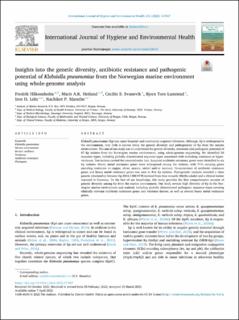Insights into the genetic diversity, antibiotic resistance and pathogenic potential of Klebsiella pneumoniae from the Norwegian marine environment using whole-genome analysis
Håkonsholm, Fredrik; Hetland, Marit Andrea Klokkhammer; Svanevik, Cecilie Smith; Lunestad, Bjørn Tore; Löhr, Iren Høyland; Marathe, Nachiket Prakash
Journal article, Peer reviewed
Published version

Åpne
Permanent lenke
https://hdl.handle.net/11250/3009656Utgivelsesdato
2022Metadata
Vis full innførselSamlinger
- Department of Biological Sciences [2216]
- Registrations from Cristin [9489]
Originalversjon
International Journal of Hygiene and Environmental Health. 2022, 242, 113967. 10.1016/j.ijheh.2022.113967Sammendrag
Klebsiella pneumoniae (Kp) can cause hospital- and community acquired infections. Although, Kp is widespread in the environment, very little is known about the genetic diversity and pathogenicity of Kp from the marine environment. The aim of our study was to understand the genetic diversity, resistome and pathogenic potential of 87 Kp isolates from the Norwegian marine environment, using whole-genome sequencing. We identified 50 sequence types, including globally disseminated sequence types associated with multidrug resistance or hypervirulence. Ten isolates carried the yersiniabactin loci. Acquired antibiotic resistance genes were identified in six Kp isolates. Heavy metal resistance genes were widespread among the isolates, with 71% carrying genes encoding resistance to copper, silver, arsenic, nickel and/or mercury. Co-occurrence of antibiotic resistance genes and heavy metal resistance genes was seen in five Kp isolates. Phylogenetic analysis revealed a close genetic relationship between Kp 2016-1200 ST25 isolated from blue mussels (Mytilus edulis) and a clinical isolate reported in Germany. To the best of our knowledge, this study provides the first comprehensive account of genetic diversity among Kp from the marine environment. Our study reveals high diversity of Kp in the Norwegian marine environment and seafood, including globally disseminated pathogenic sequence types carrying clinically relevant antibiotic resistance genes and virulence factors, as well as several heavy metal resistance genes.
